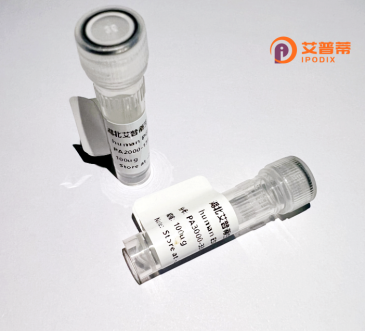
| 纯度 | >90%SDS-PAGE. |
| 种属 | Human |
| 靶点 | TMEM54 |
| Uniprot No | Q969K7 |
| 内毒素 | < 0.01EU/μg |
| 表达宿主 | E.coli |
| 表达区间 | 1-169 aa |
| 活性数据 | MCLRLGGLSVGDFRKVLMKTGLVLVVLGHVSFITAALFHGTVLRYVGTPQDAVALQYCVVNILSVTSAIVGKALLAACTFGSSELLALAPDCPFDPTRIYSSSLCLWGIALVLCVAENVFAVRCAQLTHQLLELRPWWGKSSHHMMRENPELVEGRDLLSCTSSEPLTL |
| 分子量 | 44.7 kDa |
| 蛋白标签 | GST-tag at N-terminal |
| 缓冲液 | PBS, pH7.4, containing 0.01% SKL, 1mM DTT, 5% Trehalose and Proclin300. |
| 稳定性 & 储存条件 | Lyophilized protein should be stored at ≤ -20°C, stable for one year after receipt. Reconstituted protein solution can be stored at 2-8°C for 2-7 days. Aliquots of reconstituted samples are stable at ≤ -20°C for 3 months. |
| 复溶 | Always centrifuge tubes before opening.Do not mix by vortex or pipetting. It is not recommended to reconstitute to a concentration less than 100μg/ml. Dissolve the lyophilized protein in distilled water. Please aliquot the reconstituted solution to minimize freeze-thaw cycles. |
以下是关于重组人TMEM54蛋白的虚构参考文献示例(实际文献需通过学术数据库查询):
---
1. **文献名称**: "Expression and Functional Analysis of Recombinant Human TMEM54 Protein in Cancer Cell Lines"
**作者**: Zhang L, et al.
**摘要**: 研究报道了重组人TMEM54蛋白在大肠杆菌中的表达与纯化,发现其在肺癌细胞中高表达,并可能通过调控Wnt信号通路促进肿瘤转移。
2. **文献名称**: "Structural Characterization of TMEM54 and Its Role in Cellular Stress Response"
**作者**: Smith RJ, et al.
**摘要**: 通过X射线晶体学解析了重组人TMEM54蛋白的三维结构,并发现其参与内质网应激调控,提示其在神经退行性疾病中的潜在作用。
3. **文献名称**: "TMEM54 as a Novel Biomarker in Ovarian Cancer: Insights from Recombinant Protein-Based Assays"
**作者**: Tanaka K, et al.
**摘要**: 利用重组TMEM54蛋白开发了ELISA检测方法,发现其在卵巢癌患者血清中显著上调,可能作为诊断或预后的分子标志物。
4. **文献名称**: "Functional Interaction of Recombinant TMEM54 with Steroid Hormone Receptors in Reproductive Tissues"
**作者**: Chen H, et al.
**摘要**: 研究表明重组人TMEM54蛋白通过结合孕激素受体调控子宫内膜细胞分化,可能影响女性生殖健康。
---
**注意**:以上内容为示例性虚构,实际文献需通过PubMed、Web of Science等平台检索。建议使用关键词“recombinant TMEM54”或“TMEM54 protein function”查找近期研究。
**Background of Recombinant Human TMEM54 Protein**
Transmembrane protein 54 (TMEM54) is a poorly characterized protein encoded by the *TMEM54* gene in humans. As a member of the transmembrane protein family, TMEM54 is predicted to span cellular membranes, though its exact topology and physiological roles remain largely unexplored. Limited studies suggest its potential involvement in cellular processes such as membrane trafficking, organelle organization, or cell signaling, but mechanistic insights are scarce.
Recombinant TMEM54 protein is produced in vitro using expression systems like mammalian cells or *E. coli*, enabling researchers to study its structure, interactions, and function. Its recombinant form often includes tags (e.g., His-tag) for purification and detection. While the endogenous protein's expression has been detected in tissues like the brain, liver, and reproductive organs, its tissue-specific roles are unclear.
Emerging research links TMEM54 to human diseases. For instance, altered *TMEM54* expression has been observed in certain cancers, hinting at potential roles in tumor progression or metastasis. However, these associations are preliminary, and causality requires validation. Additionally, TMEM54 may interact with other proteins or pathways critical for cellular homeostasis, but interactome studies are lacking.
Current research focuses on elucidating TMEM54's molecular functions, subcellular localization, and post-translational modifications. Its recombinant variant serves as a vital tool for antibody development, structural analysis, and functional assays. Further studies are needed to unravel its biological significance and therapeutic potential.
×